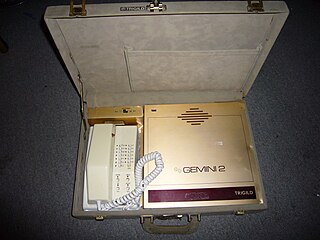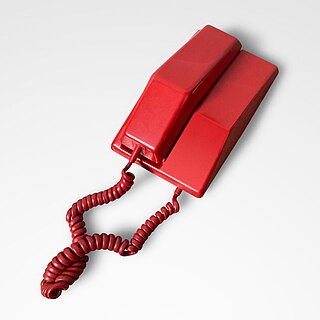
Design Line, also known as Deco-Tel, is a brand name that AT&T has used for several of its specialty telephone designs to fulfill the demand by customers for more variety in telephone models.

Design Line, also known as Deco-Tel, is a brand name that AT&T has used for several of its specialty telephone designs to fulfill the demand by customers for more variety in telephone models.
In the early 1970s, well before the Bell System divestiture, customers in increasing numbers chose to install and use telephones not manufactured by Western Electric, AT&T's wholly owned subsidiary. To fulfill the demand, the Bell System decided to offer a series of specialty telephones that could be purchased or leased. The series was called the Design Line telephones. The name did not refer to one particular telephone type; rather Design Line was the collective name given to all the specialty phones, including the Candlestick phone, Country Junction phone, Mickey Mouse phone and others. [1] The phones were among the few that could be purchased in the early 1970s.
Western Electric broke tradition, by obtaining housings for some of the sets from other manufacturers or local contractors in Indianapolis. In all cases, Western Electric supplied the internal electrical components of the phones, such as ringer, receiver, transmitter, and induction coils. Early Design Line sets displayed this disclaimer:
As a consequence, Bell customers still had to pay a monthly lease fee in order to rent the phone's internal components, which remained the property and responsibility of the local Bell provider. Design Line phones are among the few lines of phones produced by Western Electric that were more renowned for looks than durability. Because the majority of the Design Line phone housings were not made by Western Electric, Bell System standards were less stringent for exterior housings than for the phone's internals.
Beginning in around 1980, the Bell System allowed customers to own the entire phone, including internal components. Sets were marked with "CS" to indicate the phone was entirely customer owned.
Some Design Line sets had the option of rotary or touch-tone dialing others were only available with one or the other. The Design Line telephones available from the Bell Telephone Company around 1980 include: [2]
Other Design Line telephones available in the 1970s and early 1980s include: [1]
The arrangement in which Western Electric components were installed into Japanese-made housings ended around the time of divestiture. Character phones, such as the Mickey Mouse phone, were made in China using the Trimline handset, rather than just the receiver with dial in the base. These phones were still sold as a part of the Design Line series.
In 1985, AT&T Technologies redesigned its consumer telephone products to be cheaper to build and be more competitive in the marketplace by adding electronic ringers and a redial function. In 1986, they moved telephone production out of the United States. After this time several new Design Line series telephones were marketed and discontinued. One example of a "Design Line" phone was model 140, marketed in the mid 90s. The phone was similar in size to the 2554 wall phone, but had unique features:
The phone also required a handset cord which had a long straight section as the connector to the base was located on the bottom of the phone, and not facing outward on the side.
In 2000, Lucent Technologies spun off its consumer telephone division, resulting in the Design Line being redesigned. The basic design was retained, except that the handset was more rectangular in shape, and an "AT&T" badge was placed on the outside of the handset. The phone also replaced the traditional 100 series (the 2500 and 2554 telephones) for consumer use, as Lucent kept the phones because of their high demand for business use after spinning off its consumer division.

A telephone is a telecommunications device that permits two or more users to conduct a conversation when they are too far apart to be easily heard directly. A telephone converts sound, typically and most efficiently the human voice, into electronic signals that are transmitted via cables and other communication channels to another telephone which reproduces the sound to the receiving user. The term is derived from Greek: τῆλε and φωνή, together meaning distant voice. A common short form of the term is phone, which came into use early in the telephone's history.
The Western Electric Company was an American electrical engineering and manufacturing company officially founded in 1869. A subsidiary of the American Telephone and Telegraph Company for most of its lifespan, it served as the primary equipment manufacturer, supplier, and purchasing agent for the Bell System from 1881 until 1984, when the system was dismantled. The company was responsible for many technological innovations, as well as developments in industrial management.

The Trimline telephone is a series of telephones that was produced by Western Electric, the manufacturing unit of the Bell System. These telephones were first introduced in 1965 and are formally referred to as the No. 220 Hand Telephone Sets. The Trimline was designed by Henry Dreyfuss Associates under the project direction of Donald Genaro; the firm had produced the previous post-war desktop telephone types for the American Telephone & Telegraph Company.

A telephone call or telephone conversation, also known as a phone call or voice call, is a connection over a telephone network between the called party and the calling party. Telephone calls started in the late 19th century. As technology has improved, a majority of telephone calls are made over a cellular network through mobile phones or over the internet with Voice over IP. Telephone calls are typically used for real-time conversation between two or more parties, especially when the parties cannot meet in person.

The Ericofon is a one-piece plastic telephone created by the Ericsson Company of Sweden and marketed through the second half of the 20th century. It was the first commercially marketed telephone to incorporate the dial and handset into a single unit. Because of its styling and its influence on future telephone design, the Ericofon is considered one of the most significant industrial designs of the 20th century by Phaidon. It is in the collection of the Museum of Modern Art in New York City. In Sweden, the Ericofon is known as the cobra telephone for its resemblance to a coiled snake.

The Improved Mobile Telephone Service (IMTS) was a pre-cellular VHF/UHF radio system which linked to the public telephone network. IMTS was the radiotelephone equivalent of land dial phone service. Introduced in 1964, it replaced Mobile Telephone Service (MTS) and improved on most MTS systems by offering direct-dial rather than connections through a live operator, and full-duplex operation so both parties could talk at the same time.

The Western Electric model 500 telephone series was the standard domestic desk telephone set issued by the Bell System in North America from 1950 through the 1984 Bell System divestiture. Millions of model 500-series phones were produced and were present in most homes in North America. Many are still in use today because of their durability and ample availability. Its modular construction compared to previous types simplified manufacture and repair, and facilitated a large number of variants with added features.

The model 302 telephone is a desk set telephone that was manufactured in the United States by Western Electric from 1937 until 1955, and by Northern Electric in Canada until the late 1950s, until well after the introduction of the 500-type telephone in 1949. The sets were routinely refurbished into the 1960s. It was one of the most widely used American combined telephone sets to include the ringer and network circuitry in the same telephone housing.
VTech Innovation, L.P., doing business as Advanced American Telephones, is a telephone manufacturing company.
AT&T Technologies, Inc., was created by AT&T in 1983 in preparation for the breakup of the Bell System, which became effective as of January 1, 1984. It assumed the corporate charter of Western Electric Co., Inc.

The Princess telephone was introduced by the Bell System in 1959. It was a compact telephone designed for convenient use in the bedroom, and contained a light-up dial for use as a night-light. It was commonly advertised with the slogan "It's little...It's lovely...It lights", which was suggested by Robert Karl Lethin, an AT&T employee.
QLT Consumer Lease Services, formerly AT&T Consumer Lease Services, is a New Jersey-based telephone equipment leasing company. The company provides telephone leasing services to residences and small businesses in the United States. These services include next business day replacement of the leased product for any reason.

The 1A2 Key Telephone System is a business telephone system developed and distributed by the Western Electric Company for the Bell System.

The model 5302 telephone was a look-alike product to the 500-type telephone that was introduced as a stopgap by Western Electric in 1955 to meet the increasing post-World War II demand for a modernized telephone. It reused existing component supplies from the older model 302 that the model 502 replaced. The 302 had been issued since 1937, but starting in 1950, units were replaced with the new 500-series sets, without having served their useful component life.

The Trimphone is a model of telephone designed in the early 1960s in the UK, the first prototypes appearing in 1965. It was positioned as a more fashionable alternative to the standard telephones available from the Post Office Telephones, the nationalised predecessor to British Telecom. The name is an acronym standing for Tone Ring Illuminator Model, referring to the then innovative electronic ringer and the illuminated dial. The luminous dial or betalight contained the mildly radioactive element tritium, which later caused some concern about safety. In June 1991 the United Kingdom Atomic Energy Authority at Harwell was fined £3,000 by Wantage Magistrates Court for accumulating radioactive waste, having collected several thousand Trimphone luminous dials in a skip.
The General Post Office (GPO) of the United Kingdom carried the sole responsibility for providing telecommunication services across the country with the exception of Hull. The GPO issued a range of telephone instruments to telephone service subscribers that were matched in function and performance to its telephone exchanges.

The candlestick telephone is a style of telephone that was common from the late 1890s to the 1940s. A candlestick telephone is also often referred to as a desk stand, an upright, or a stick phone. Candlestick telephones featured a mouthpiece (transmitter) mounted at the top of the stand, and a receiver (earphone) that was held by the user to the ear during a call. When the telephone was not in use, the receiver rested in the fork of the switch hook protruding to the side of the stand, thereby disconnecting the audio circuit from the telephone network.

The push-button telephone is a telephone that has buttons or keys for dialing a telephone number, in contrast to having a rotary dial as in earlier telephone instruments.

The Contempra is a telephone designed and produced by Northern Electric beginning in 1967. Contempra was the first phone designed in Canada, previous Canadian sets having been designed in the US for Western Electric and built under licence.

The Western Electric hand telephone sets comprise a series of telephones that were produced from 1927 by the Western Electric Company for the American Telephone and Telegraph Company (AT&T) and the Bell System. The series features the mouthpiece (transmitter) and the earpiece (receiver) combined into a hand-held unit, originally named a hand telephone, or handset. The handset would be held against the ear and in front of the mouth simultaneously, in contrast to earlier telephones in the Bell System where only the receiver was held against the ear, while the user spoke into a fixed transmitter mounted on a telephone stand or wall telephone.